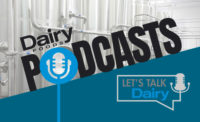Dairy processors make great sustainability strides
Goals for carbon and climate neutrality appear to be in reach

Photo courtesy of NicoElNino via geetyimages.com.
The sustainability finish line has been set: climate and carbon neutrality. The end zone seems to be within reach.
Current efforts to reduce methane gas are a great start toward achieving this goal. Researchers from the CLEAR Center at the University of California (UC) at Davis concluded in a recently released, peer-reviewed study, that the California dairy sector is on target to reach its methane-reduction goals and ultimately reach climate neutrality by 2030.
“What’s most exciting about this study is that it shows the aggressive methane reductions the dairy sector has pursued will not only lead to a point in which they are no longer adding warming to the atmosphere, but can go further and chip away at historical emissions. Agriculture is one of the few sectors that can do that,” states UC Davis professor and air quality specialist Frank Mitloehner. “The rest of the world is looking at how California is reducing methane, and sees that significant reductions are possible and have a big impact on a sector’s climate footprint.”
Dairy foods play an important role because they provide essential nutrients needed throughout life, as well as other diverse bioactive compounds, embedded within their unique food matrix, says Amy DeLisio, CEO of the Dairy Council of California.
“The report from the CLEAR Center showcases that climate neutrality for the dairy sector is possible by 2030, and the industry is well on its way,” DeLisio maintains.
She highlights that progress made to date is a testament to innovation occurring throughout the California dairy community, “including alternative manure management, the use of energy-efficient lighting, cooling and pumping methods and solar energy, as well as investing in anaerobic digesters to capture and convert methane in manure to biogas for clean energy.”

Denise Mullinax, executive director, of California Dairy Research Foundation, Davis, Calif., adds California dairy farm families have really stepped up to not only reduce methane impacts but to also improve water quality. “By participating in voluntary, incentive-based, and market-driven approaches, such as the California Department of Food and Agriculture (CDFA)’s AMMP and Dairy Digester programs, our farmers are demonstrating a commitment to improvement that no other state has yet matched,” she notes.
Although progress has been tremendous throughout the dairy industry, more can be done to reach climate-neutral goals. One thing coming around the pike is the USDA’s Partnership for Climate-Smart Commodities grant funds being awarded starting this upcoming year.
“We continue to see more and more dairy farmers assessing their facilities for opportunities to add improved on-farm technologies and practices. These voluntary and incentive-based programs are key to allowing the industry to be flexible and adopt the most effective practices for each individual operation,” Mullinax relays.
In the future, research remains a critical component of implementing successful advanced manure management practices, technology assessment, and enteric methane mitigation strategies, Mullinax adds.
“Our dairy farmers rely on us for timely and comprehensive assessments of innovative technologies and advanced practices to allow them to make the best decisions considering the operational layout and management of their facilities,” she explains.
Individual success stories
In California and beyond, many individual dairy processors have implemented successful sustainability initiatives that are already paying dividends. One such processor is Tillamook, Ore.-based Tillamook County Creamery Association (TCCA). The TCCA Climate Action Plan aligns with the Innovation for U.S. Dairy’s Stewardship Commitment to reach net zero greenhouse gas (GHG) emissions by 2050.
To spur progress toward the net-zero goal, TCCA set its own interim goal of 30% reduction in absolute emissions by 2030, states Paul Snyder, executive vice president, Stewardship, TCCA.
“Sustainability is top of mind for many businesses at the moment, but for farmers, it’s a must —not a maybe,” Snyder tells Dairy Foods. “Climate change is a significant threat to the farming business, as natural disasters destroy our lands and displace our most vulnerable community members. Since our founding in 1909, TCCA farmer-owners have built everything with a long-term mindset to ensure the farms and communities are here for generations to come.”
While TCCA’s sustainability efforts are ongoing, Snyder highlights some of the plan’s major focuses:
- Truck Fleet Conversion: TCCA converted its 16-truck fleet to a new fuel called renewable diesel (R99) in late summer 2022. As a result, it reduced their total fleet emissions by more than 20% from 2021 to 2022. Moving forward, it will reduce fuel emissions by 66% per gallon, when compared to conventional diesel.
- Food Waste Diversion: TCCA started diverting all loose and packaged cheese scraps at its Boardman cheese-making facility to a food waste processor that uses the cheese for animal feed and compost. More than 955,000 pounds of cheese scraps were diverted from its Boardman facility last year, increasing the diversion rate from 15% to more than 60% at the site. In turn, the diversion also reduced the Boardman’s facility landfill-based emissions by over 30%.
- Soil Carbon Benchmarking: Half of all TCCA member farms opted into a new benchmarking program to measure the amount of carbon stored in their farmland. Partnering with an expert soil sampling company, TCCA measured its total carbon storage and found the average carbon in the soil among participating member farms to be 53 metric tons/acre, representing some of the highest carbon storage among all land use across the United States and Mexico. By establishing a soil carbon baseline, TCCA is increasing the quality and accuracy of greenhouse gas (GHG) emission’s measurement, allowing the co-op to accurately track progress toward its goals.
- GHG Measurement and Reduction: TCCA reports a 9% reduction of total GHG emissions compared to its 2020 baseline and continues to improve its data to get a clearer picture of emissions. To understand farm-specific practices and associated emissions, participating TCCA farmers took a voluntary survey to measure their specific GHG footprint. The Farmers Assuring Responsible Management Environmental Stewardship survey evaluates the entire lifecycle of dairy production including the number of cows, amount of electricity, and fuel consumption — as well as feed production and manure management practices — to determine a farm’s footprint.
2030 and beyond
Land O’Lakes Inc. also has marked 2030 in its calendar as a key date. It recently received approval from the Science Based Target Initiative for its 2030 goal to reduce Scope 1 and 2 emissions by 42% and Scope 3 by 25%.

“We will then further reduce our emissions to achieve net zero in 2050. All of our Land O’Lakes businesses: Dairy Foods, Animal Nutrition, WinField United, and Truterra, have many initiatives that will help us achieve these aggressive goals,” Yone Dewberry, chief supply chain officer for Land O’Lakes, tells Dairy Foods.
The Arden Hills, Minn.-based company launched its Community Impact Report last month, which details its sustainability efforts, which include:
- WinField United Advanced Acre Rx prescription program, which provides farmers with a customized regimen of products and techniques to optimize yields, support environmental outcomes, and improve profit, all backed by a service warranty. “Also with our agriculture sustainability business, Truterra, that helps farmers adopt on-farm conservation strategies, which paid more than $5.1 million to farmers for approximately 262,000 metrics tons of carbon stored through its carbon program in 2022,” Dewberry states.
- Expanding sustainable packaging: There are multiple efforts underway across Land O’Lakes to address its goal of reaching 100% reusable, recyclable or compostable consumer packaging by 2030. By developing and implementing new packaging and recycling processes across its businesses, Land O’Lakes reached the 60% mark in 2022, Dewberry notes.
- Enabling global farmers to succeed: Via its nonprofit Venture37, Land O’Lakes supported and helped over 546,000 farmers adopt agriculture techniques and technologies in more than 80 low- and middle-income countries like Kenya and Tanzania.
Further sustainability efforts include Land O’Lakes Dairy Foods team, who in 2021 created the Dairy 2025 Commitment to help its 1,300-plus member-owners complete an intensive on-farm sustainability assessment by 2025. Data points in the assessment include fuel, electricity, and water usage, nutrient application, crop rotation, and manure management.
“Another specific example is with our WinField United team, who over the last few years have taken steps to minimize one-off or half-full deliveries, investing in digital tools, systems, and capabilities to maximize the load efficiency of trucks making deliveries. In 2020, the average weight of product per load was 11,000 pounds,” Dewberry states. “In 2022, that average rose to 21,000 pounds, a 90% increase. This improvement efficiency has resulted in taking 17,000 shipments off the road, which equates to 2.4 million fewer miles traveled and a 3,400 metric-ton emission reduction.”
Land O’Lakes also recently learned that two of its largest dairy member-owners had excess renewable energy from their methane digesters in Pennsylvania. The Minnesota company partnered with World Kinect Energy Services to purchase the renewable energy credits directly from its members at a fair market value.
“This energy partnership is mutually beneficial. Not only does it help our members financially, but it also gives Land O’Lakes a continual flow of credits to help reduce our carbon footprint,” Dewberry relays.
Lastly, Land O’Lakes’ Vermont Creamery is partnering with Vanguard Renewables and the Farm Power Strategic Alliance to turn food waste into low-carbon renewable energy via Vanguard’s Farm Powered anaerobic digesters and Organics Recycling Facility.
A co-op’s coordinated effort
Kansas City, Kan.-based Dairy Farmers of America (DFA)’s family farm owners are always thinking about the next sustainable effort or technology, the company reports.

“As a cooperative founded, owned, and governed by dairy farm families, we’re committed to being a part of climate solutions and are taking a variety of actions to help reduce our impact on the environment such as using less energy and water, reducing waste, as well as methane and identifying transportation and hauling efficiencies to name a few,” says Hansel New, DFA’s director of sustainability programs.
Specific examples of DFA’s sustainability efforts include
- Reducing water use: The company’s ingredients plant in Garden City, Kan., operates as a water-efficient facility and was built with a focus on conserving natural resources as much as possible, including its wastewater treatment facility. “With this process, all the water used to process milk at the plant is recycled and can be used by the city as a source of non-potable water used to water landscaping and parks throughout the local community,” New relays.
- Reducing energy: DFA’s processing plant in Middlebury Center, Pa., is using a 1.9-megawatt (MW) ground mount solar installation to help reduce its energy usage. The solar panels provide approximately 20% of the plant’s yearly electricity needs and generate an estimated more than 2 million kilowatts per hour (kWh) annually, offsetting the equivalent of 1,426 metric tons (MT) of carbon dioxide equivalent each year. “This usage equates to taking more than 300 cars off the road, or the equivalent energy use of 180 homes for a year. Additionally, five of our DFA plants in California are taking steps to reduce energy demands by participating in the California Energy commission grant program,” New notes.
- Reducing waste to landfill: Although many DFA plants are making strides to divert their waste, its Kemps ice cream plant in Rochester, Minn., has achieved zero waste to landfill status. In 2022, the plant sent more than 9 million pounds of food waste to become feed for an animal nursery that it has partnered with in repurposing efforts. Any unsellable finished product and packaging is used by the county to turn waste into energy.
DFA has certainly made great sustainability accomplishments, but it is no way stopping there. According to New: “We are proud to lead the way as the first U.S. dairy cooperative to establish a science-based target (SBT) and are striving to reduce both direct and value chain greenhouse gas emissions by 30% by the end of 2030. Additionally, the cooperative is part of an industry-wide collaboration on environmental sustainability through the Innovation Center for U.S. Dairy. As part of this collaboration, the dairy industry has committed to be carbon neutral or better by 2050, and DFA is a key contributor in working toward this goal.”

How will DFA meet these sustainability goals in the future? New provided these answers:
- Mitigating methane emissions from cows by supporting advances in feed efficiency, herd nutrition, and feed additives designed to reduce emissions.
- Using renewable energy methods, such as solar panels and wind power, on its farms and in its plants.
- Utilizing anaerobic digesters on farms, which convert manure and food waste to energy.
- Promoting healthy soils and regenerative agriculture to sequester more atmospheric carbon in the ground.
- Creating transportation and hauling efficiencies to reduce emissions; and
- Exploring innovative technologies and solutions to reduce emissions and promote environmental stewardship.
North American effort
Agropur, which serves all of North America, takes an active role in supporting its customers’ sustainability journeys on initiatives such as GHG emissions reduction, recyclable packaging and food waste reduction.
This spring, Agropur announced its greenhouse gas reduction targets, which have been approved by the Science Based Targets initiative. Agropur is committed to a 30% reduction in GHG emissions generated by its plants in Canada and the United States by 2031. It is also committed to reducing GHG emissions across its value chain by 24% per kg of milk processed in the same timeframe.
Agropur continues to work actively with dairy industry leaders across Canada and the United States to achieve net zero emissions by 2050.
“We’re also making great strides toward more responsible operations that reduce waste, conserve water, upcycle biosolids, and become more efficient thereby reducing emissions,” explains Maxime Devourdy, vice president, of corporate development and sustainable growth strategy, for the Longueuil, Québec, Canada dairy processor.
Specifically, Agropur is enacting the following sustainability initiatives:
- In Canada, 54% of electricity consumed by Agropur facilities comes from renewable sources including hydroelectricity and solar, wind, or tidal energy. Agropur has also been able to reduce energy intensity in its U.S. operations by about 7.5% since 2016. For example, all of its U.S. plants have nearly 100% LED lighting and efficient motor technology, which is saving more than 22 million kWh annually.
- In 2022, Agropur debuted new packaging for its OKA cheese in Canada. It designed its new box to be 100% recyclable in response to consumer trends and its desire to reduce overpackaging. The new box uses 43% less cardboard and is more locally sourced. The change brings a reduction of more than 159,000 kg of carbon dioxide equivalents or the same as saving 66,000 liters of gasoline annually.
- Agropur began upcycling 8,000 tons of mineral and nutrient-rich biosolids per year from its water filtration processes in South Dakota.
- In 2022, Agropur launched its Sustainable Farms Pilot Project in Canada, which aims to create a two-way collaborative process between the cooperative and its dairy farmer members. Sustainable Farms also facilitates communication with members regarding animal welfare and their environmental improvements and performance.
Global effort
Sustainability does not exist in a vacuum. Instead, it is a global concern. Vevey, Switzerland-based Nestlé is taking on this challenge by exploring different approaches to reduce dairy’s greenhouse gas emissions. In fact, the company works with dairy farmers around the world on more than 100 full-scale climate projects.
Nestlé is working with farmers, suppliers, universities, industry organizations, start-ups, and local governments to research, test, validate, and scale up different agricultural solutions and technologies, including for dairy livestock.
One area of research is on feed supplements that can reduce methane emissions from enteric fermentation, the cow’s digestion process, and the largest source of emissions in fresh milk production.
“In the United States, for instance, Nestlé is facilitating research to assess the efficacy and the human, animal and environmental health and safety aspects of feed supplements, which have the potential to reduce enteric methane emissions,” the company states in a news release.
Nestlé also partners with farmers to implement regenerative agriculture practices such as the introduction of cover crops or more widespread use of organic fertilizers to cut emissions in the production of feed.
“Farmers on one of Nestlé's pilot farms in South Africa, for instance, are growing their own multispecies pasture for animal feed while reducing the use of chemical fertilizers. This helps improve soil quality, which enables more carbon capture. The company also supports farmers in calculating exactly how much feed cows need based on factors like weight, age and gestation period to reduce overfeeding and waste,” the Swiss company notes.
There is no one-size-fits-all approach, Nestlé concludes. “Different practices and different solutions need to be applied in different combinations depending on an individual farm’s crops, livestock, environment, soil type, and many other factors. Solutions to reduce dairy emissions will be essential in Nestlé’s journey to reach net zero greenhouse gas emissions by 2050.”
Looking for a reprint of this article?
From high-res PDFs to custom plaques, order your copy today!






